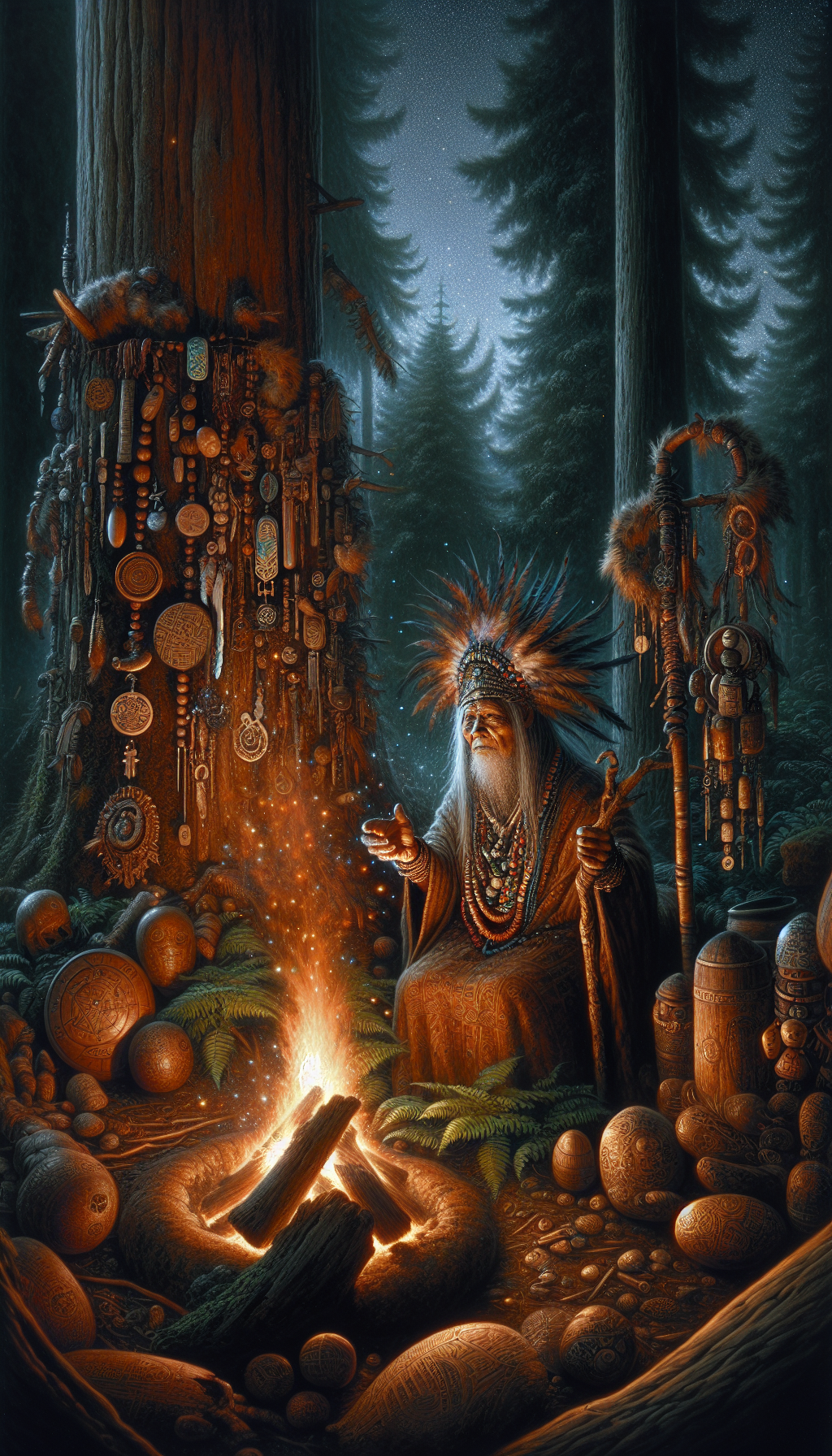What is a Shaman ?
 Shaman Totem Warrior
Shaman Totem WarriorShamans are healers who communicates with the spirit world. In this article, we’ll explore what is a shaman, their roles, practices, and cultural significance.
Defining a Shaman
The word ‘shaman’ originates from the Manchu-Tungus language, specifically from the term ‘šaman,’ meaning ‘one who knows’. This term encapsulates the essence of the shaman’s role as a knower of secrets and mysteries, a guide who navigates the spirit world. Historically, shamans have been pivotal in their societies, serving as intermediaries between the physical and spiritual planes.
Shamans are often characterized by unique mental traits, such as heightened sensitivity and intuition, which may sometimes be accompanied by physical anomalies. These traits enable them to perceive and interact with the spirit world in ways that others cannot. The shaman’s physical body is seen as a vessel through which spiritual knowledge and power flow, facilitating healing and guidance.
Understanding the historical and cultural contexts of shamanism is essential for aspiring shamans. Shamanistic beliefs and practices are deeply rooted in the traditions and histories of indigenous cultures worldwide. Different cultures have their specific interpretations and methods, but the core shamanism principles often remain consistent.
The influence of shamanism extends beyond indigenous culture practices; it has permeated popular culture, from literature and films to art. These portrayals, although sometimes romanticized or misunderstood, highlight the enduring fascination and respect for shamanic figures. This widespread interest underscores the universal appeal and significance of shamanic knowledge.
The Role of a Shaman
A spiritual leader who practices shamanism is often referred to as a wise shaman. This title reflects their possession of spiritual powers and a deep understanding of both the physical and spirit worlds, as well as the conditions of human beings. The shaman's body serves as a medium through which spirit beings convey their guidance and healing energy.
The role of a shaman is multifaceted, encompassing healing, divination, and communication with the spiritual world. Shamans are healers who address both physical and spiritual ailments. In many cultures, it is believed that spiritual issues can manifest as physical illnesses. Shamans can restore health by addressing and mending these spiritual ailments through their special powers and abilities.
Spirits of light and animal spirits play a crucial role in shamanic spiritual practice. These are spiritual entities that assist shamans in their work, providing guidance, protection, and knowledge during shamanic journeying. The relationship between a shaman and their spirit team is symbiotic, with the shaman offering respect and rituals in exchange for assistance in navigating the spirit world.
Shamans act as intermediaries between the human realm and spiritual entities. This intermediary role is vital, as shamans facilitate communication and interaction between human beings and the spirits, ensuring harmony and balance. This might involve guiding souls of the deceased, retrieving lost souls, or even negotiating with malevolent spirits to protect their community.
The journey to becoming a shamanic practitioner involves significant personal growth and spiritual development. It is not merely a profession but a calling that demands dedication, discipline, and a deep connection with the spiritual world. A true shaman undergoes rigorous training and often faces personal trials that shape their abilities and understanding.
Shamanic Practice Across Cultures
 Female Shaman - shamanic path - inner calling
Female Shaman - shamanic path - inner callingShamanism is a universal phenomenon, present in many cultural contexts across Asia, Africa, Australia, and North and South America. Each culture has its unique interpretation and practice of shamanism, yet the core principles often remain the same. Most shamans in tribal cultures serve as healers, diviners, and spiritual advisors, reflecting the diverse yet interconnected nature of shamanic traditions. They are strongly connected to the elemental forces of the natural world.
Some information of interest:
While many shamanic cultures have male shamans, in South Korea, Korean shamans are predominantly female.
Common rituals in shamanism include drumming, dancing, and the use of local substances, such as Ayahuasca, to induce trance states. These rituals are designed to alter the shaman’s state of consciousness, allowing them to access the spirit world and gather insights or perform spiritual healing. The techniques and tools used may vary, but the underlying goal of connecting with the spirit world remains consistent.
The practice of shamanism is influenced by specific social and environmental conditions. In small-scale societies without organized religions, shamanism often emerges as a means to understand and interact with the spiritual dimensions of life. These practices are shaped by the needs and belief systems of the community, reflecting a deep connection to the environment and the traditions of ancestral spirits.
Researching the practices of shamanism related to one’s ancestry can help in finding a practitioner aligned with your cultural background. This connection to one’s roots can enhance the effectiveness of shamanic healing, as the practices and beliefs resonate more deeply with the individual’s cultural heritage. Understanding these cultural variations enriches our appreciation of shamanism’s diverse expressions.
Shamanic Journeying and Trance State
 vision from the spirit world
vision from the spirit worldShamanic journeying is a cornerstone of shamanic practice, involving a trance state to access spiritual realms for guidance and healing. Shamans typically enter an trance state through rituals that include drumming, chanting, singing and dancing. These activities help to shift their awareness and open the gateway to the spirit world.
Different types of shamanic journeys serve various purposes. Soul retrieval, for instance, aims to reclaim lost parts of one’s soul that have been fragmented due to trauma. Power animal retrieval involves reconnecting individuals with their animal spirit guides, which provide strength and protection. These journeys are essential for restoring personal power and balance.
Shamanic healing techniques in an altered state are diverse and creative. Practices like spiritual extraction are used to remove evil spirits, negative energies and any destructive force that do not belong to the individual. This may involve breathwork, special tools, or even psychopomp work- guiding disembodied spirits to the afterlife. Cord cutting is another technique used to sever unhealthy energetic ties, promoting emotional and spiritual freedom.
Transfiguration, a foundational healing practice, involves merging with spiritual light to promote profound healing as a religious practice within the spiritual dimension. Through these journeys and techniques, shamans can access non-ordinary reality, bringing back valuable insights and healing energies that benefit their communities. The ability to navigate these altered states is what sets shamans apart as powerful spiritual healers.
Healing and Rituals in Shamanism
 Elemental Power - physical world by Tai
Elemental Power - physical world by TaiShamans perceive the root of illnesses as spiritual issues, addressing them through practices that involve healing the soul. This holistic approach considers both spiritual and non-spiritual aspects of illness, aiming to restore balance and harmony within the individual. Shamanic practitioners utilize techniques like soul retrieval and guided meditation as part of their treatment process.
Clinical studies have shown that shamanic healing can yield lasting improvements in conditions like temporomandibular joint disorders (TMDs), with positive effects persisting for at least nine months after treatment. Participants receiving shamanic healing reported significant reductions in pain and functional impairment associated with TMDs. These findings highlight the potential of shamanic practices to address a range of health issues.
Rituals play a crucial role in shamanic practices, aiding shamans in connecting to non-local information and the spirit realm. These rituals, which may involve drumming, chanting, or other ceremonial activities, facilitate the shaman’s journey into the spiritual world. Through these connections, shamans can access insights and healing energies that are not available in ordinary reality.
Qualitative analysis from research suggested that many individuals experienced enhanced psychosocial well-being after undergoing shamanic treatment. This reinforces the idea that shamanic healing is not just about addressing physical ailments but also about promoting overall well-being and spiritual growth. The integration of these practices into one’s life can lead to profound transformations.
How to Become a Shaman
 Calling of Shaman allies -by tai
Calling of Shaman allies -by taiBecoming a shaman often involves significant personal trials and crises, viewed as a calling from the spirits. These experiences, which can be physical or mental, are seen as necessary for gaining the spiritual insights required for shamanic practice. Many shamans enter their roles through life-or-death experiences that shape their understanding and abilities.
Training with a mentor is crucial for those aspiring to become shamans. A mentor provides guidance, support, and the transmission of shamanic knowledge and techniques. Formal training or initiation with certain tribes can also be a path to becoming a shaman, ensuring that individuals are properly prepared and connected to the shamanic tradition.
Individuals are often chosen by spirits based on their sensitivity and openness to the spirit world. This selection process is not random but is guided by the spirits’ recognition of an individual’s potential to serve as a shaman. The journey to becoming a true shaman is one of personal growth, spiritual development, and a deep commitment to the practice.
This can take many years of rigorous training.
Shamanism in Contemporary Society
Shamanism continues to play a vital role in contemporary society, providing spiritual guidance and healing that complements everyday life. The practices and beliefs of shamanism offer a unique perspective on the interconnectedness of the physical and spiritual worlds, enriching our understanding of life and nature.
Community recommendations are invaluable in finding reputable practitioners. Engaging with local spiritual communities can provide insights into the reliability and effectiveness of shamans, ensuring that individuals receive the best possible guidance and healing. This community-based approach reinforces the importance of trust and connection in shamanic practices.
Finding a Shamanic Practitioner
Finding a reliable and effective shaman involves several considerations. Community recommendations can provide valuable insights into the practitioner’s reputation and effectiveness. Engaging with local spiritual communities can help identify practitioners who are respected and trusted.
It is important to check the practitioner's spiritual background and formal training. This ensures that they have the necessary knowledge and skills to perform shamanic healing safely and effectively. Asking about their history and background can also help gauge their level of experience and understanding of shamanism.
Beware of those who visit South America or elsewhere and attend a few shamanic ceremonies, only to return believing they are shamans ready to perform ceremonies.
Inquiring about specific techniques or modalities the practitioner offers is crucial. This ensures that their methods align with your healing needs. Scheduling a preliminary meeting or session can help assess your comfort level with the practitioner and their methods.
Consider the practitioner’s energy and presence; it’s important to feel a connection and trust. Reviewing testimonials from other clients can provide insights into their experiences and outcomes with the practitioner. These steps will help you find a shaman who can effectively guide and heal you.
Evidence and Research on Shamanism
Shamanic healing is a practice rooted in historical traditions that seeks validation through academic studies and shamanic studies. Despite limitations such as small sample sizes, shamanistic research suggests a need for further investigation into the efficacy of shamanic healing methods. These studies aim to bridge the gap between traditional practices and modern scientific understanding.
Some findings indicate that shamanic healing may have therapeutic benefits. These benefits highlight the potential for shamanic practices to complement conventional medical treatments, offering holistic approaches to health and well-being. Further research could uncover more about the mechanisms and effectiveness of these ancient healing practices.
The implications of this research are important for both practitioners and patients. Recognizing the potential benefits of shamanic practices in healing can guide treatment decisions and promote the integration of these methods into wider healthcare systems. This ongoing investigation of shamanism’s therapeutic potential highlights the need for continued academic research.
Summary
Shamanism, with its roots in ancient cultures, continues to offer profound insights and healing practices in the modern world. By understanding the role of shamans, their practices, and the cultural contexts from which they arise, we can appreciate the depth and richness of this spiritual tradition. Through shamanic journeying, healing rituals, and the guidance of spirit guides, shamans serve as vital intermediaries between the physical and spiritual planes.
Today’s shamanic practitioners blend traditional knowledge with contemporary needs, providing holistic healing that addresses both spiritual and physical ailments. The integration of shamanic practices into modern life underscores their relevance and potential to enhance well-being. Finding a reliable shamanic practitioner can lead to transformative experiences and deeper spiritual connections.
As we conclude this exploration of shamanism, we hope to have illuminated the path for those interested in this ancient practice. Embracing shamanism offers a journey into the mystical, the unknown, and the profoundly healing. May this guide inspire you to delve deeper into the world of shamanism and discover the wisdom it holds for your life.
Click below and views more than 600 pieces of spiritual artwork

Spiritual Books
If you enjoy the articles on this website, you will also appreciate the short stories in the books below. Click here and continue the journey.



